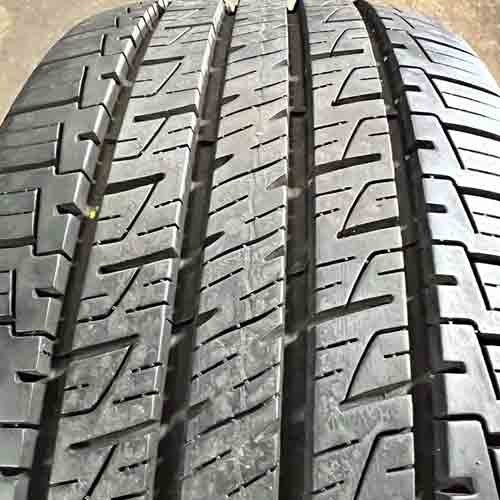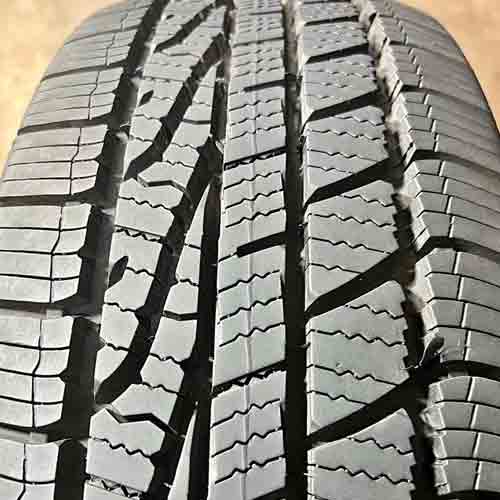Both are great choices, where the Assurance MaxLife is Goodyear’s fuel-efficient, long-lasting tire for sedans and crossovers, offering reliable all-season traction. Meanwhile, the Assurance WeatherReady is a premium Grand Touring tire for a broader vehicle range, prioritizing comfort. Let’s see which is for you.

Being a tire engineer, my tests show that the Goodyear Assurance WeatherReady offers enhanced wet and winter grip and a smoother ride, while the Assurance MaxLife excels in dry conditions, fuel efficiency, and tread life.
Table of Contents
Tire Sizes
The Goodyear Assurance MaxLife comes in 15 to 20 inches wheels, and all of those sizes have following specs.
- Speed ratings: H and V.
- Load ratings: SL and XL.
- Tread depth range: 11 to 12/32″.
- Weight range: 20 to 36 lbs.
- Treadwear warranty: 85k miles.
- UTQG rating: 820 A B.
Review this tire in greater details: https://tiredriver.com/goodyear-assurance-maxlife-review/
On the other side, the Goodyear Assurance WeatherReady has sizes with following specs.
- Rim sizes: 15 to 20 inches.
- Speed ratings: T, H and V.
- Load ratings: SL and XL.
- Tread depth: Either 10/32″ or 11/32″.
- Weight range: 19 to 37 lbs.
- Winter ratings: Yes both M+S/3pmsf available.
- Tread warranty: 60k miles.
- UTQG: 700 A A.
Review this tire in greater details: https://tiredriver.com/goodyear-assurance-weatherready-review/
Tread Design
Let’s start off with the Goodyear MaxLife.

The tire showcases a symmetric tread pattern, consisting of five ribs, which collectively form 4 central circumferential channels.
Though as these ribs don’t have proper lateral grooves (as they are continuous running), you get limited overall resistance to hydroplaning.
(This is because hydro or aquaplaning is highly linked with water dispersion through grooves).
Though this mostly goes for the central most rib with least no. of biters.
While the adjacent ribs are slightly more voided up with their prominent notches and thick siping.
Same is the case with shoulders, where you see thick F shaped siping, and notches.
Getting into its internal construction, the tire is equipped with a lightweight single-ply polyester and nylon cap. And this is complemented by dual steel belts sandwiched between them.
Moving towards the other Goodyear tire, you see an asymmetric tread construction.

Now the Assurance WeatherReady also features three distinct ribs that create four circumferential channels, just like its peer.
But its overall much more aggressive.
(I mean it interconnects its grooves prominently allowing for better water dispersion, adding to the tire’s wet traction).
It’s central most (and narrowest) rib is laced with notches and wave-like siping.
While neighboring blocks although have similar siping pattern, their multi-angled designed allow for grip in all directions.
These adjacent ribs are characterized by a lot of biters such as needle shaped chamfered edges, and zigzag sides.
The shoulders are the least aggressive though, only carrying linear sipes (and longitudinal slits connecting them).
Internally, the tire is fortified with a 2-ply polyester casing and broader twin steel belts, as well as a singular polyamide reinforcement cap ply.
Dry Performance
Dry tire performance can be distilled into three main categories: dry grip, handling, and steering responsiveness.
Let me discuss each of these aspects one by one.
Dry Grip
The core of directional grip rests in the central portion of the tread, where the majority of the rubber meets the road, as the tire rolls straight.
Given this, it’s understandable why the Assurance WeatherReady could benefit from enhanced braking efficiency, which is the direct measure of this grip.
The tire comes with an lateral and longitudinal voids all over the tread, diminishing the amount of rubber available for direct road contact, which in turn affects grip.
Moreover, its relatively heavier compound also creates more momentum, which is slightly more difficult to stop in comparison.
On the other hand, the Goodyear Maxlife emerges superior, striking an ideal balance between braking and acceleration.
It’s 3 continuous running ribs in the middle contribute to its performance the most. These not only offer optimal contact with the ground, but also offer a great on-center feel, as they are all sitting on a secondary rubber layer.
This layer basically act as reinforced foundations for all the lugs/ribs, adding to the tire’s overall stability and grip.
Dry Handling
Handling is the mixture of lateral grip and steering response of a tire.
And the Goodyear Assurance MaxLife again takes the lead, showcasing impressive results, thanks to its well designed shoulders.
Given that the shoulders are the primary points of contact with the road (as tire corners), MaxLife with its more streamlined tread design, ensures a better rubber-to-road interaction, resulting in an impressive lateral traction.
On the other side, the Goodyear Assurance WeatherReady doesn’t quite measure up to the same standard. I mean sure, its lateral grip is good enough, but it still lacks to its counterpart by over 2 seconds (referring to averaged handling times on laps).
The reason? Well the tire has a slightly heavier built and a softer, more pliant rubber composition. Both these factors although help the tire with snow traction, it also makes the tire’s lugs susceptible to flexing.
Basically, when it comes to overall handling, the bending of the lugs are very counterproductive. This is because with them flexing, the tread requires time to revert to its original shape. And this recovery time translates in to lap times.
Overall Ride Comfort
2 key areas are worth considering, when it comes to overall ride comfort. Noise generation and bumps absorption. Let’s talk both.
Noise Generation
Air is the primary culprit behind overall tread noise.
These air particles, predominantly entering through shoulders, collide with the tread walls, causing pattern noise, and in-groove resonance, resulting in tread vibrations.
Now, upon examining the tread design, it can be seen how the Goodyear Assurance MaxLife clearly prioritizes ride comfort.
I mean the compact shoulder lugs of MaxLife effectively limit the entry of air, while the WeatherReady, with its relatively more voided up tread design, tends to be noisier by comparison, letting air particles circulate and collide around with greater intensity.
However, it could have been worse if not for its varying pitch tread design. This design ensures that air particles striking the tread produce different tones that cancel each other out, preventing noise amplification.
Ride Comfort
Ride comfort essentially depends on a tire’s ability to manage uneven terrains. And here the overall composition of the tire is pretty significant.
Given this criterion, it’s understandable why the Goodyear Assurance MaxLife registers lesser subjective scores, in terms of impact-comfort performance, where its firmer rubber composition struggles to efficiently absorb road imperfections.
On the other side, the Goodyear Assurance WeatherReady, branded with 3PMSF rating, owing to its softer thermally adaptive rubber, promises and delivers a more soaking and stable drive over irregularities.
Fuel Economy
Fuel efficiency in tires is influenced by a combination of factors, where some of the most important once are following.
- Tire’s overall weight: This includes, both the internal and external structure of the tire.
- Rolling resistance: This denotes how effectively the tire’s lugs adhere to the road’s surface.
- Rubber composition: Specific polymers are integrated to boost fuel economy, without sacrificing grip.
Considering these variables, it’s clear why the Goodyear Assurance MaxLife ends up getting greater scores in overall fuel economy.
The tire is slightly lighter, relatively more rigid, and has polymers dedicated to provide longevity (by lowering rolling resistance).
And all of these directly help the tire with its fuel efficiency.
On the other hand, the Assurance WeatherReady’s heavier weight concentrates on a smaller lug area (since its tread is more voided up). This creates a lot more rolling resistance in comparison.
And yes, here its softer compound is also not helping, as it leads to excessive lug flexing. So energy is wasted in to reshaping of it’s deformed tread, (instead of being used into the actual movement of the tire).
Overall Wet Performance
The efficacy of a tire’s wet performance hinges on its ability to effectively move water away from the tread, thus maintaining a consistent rubber-to-road contact. And it’s achieved by grooves and sipes.
Grooves are the obvious ones, countering hydroplaning, while sipes, on the other hand, provide the finishing touches by removing residual water, where they create a suction (by flexing), providing a relatively drier surface for biters/rubber to grip on.
That’s why comparing both tires, it makes sense why the Goodyear Assurance WeatherReady shows up with better wet handling and braking overall.
The tire is more voided up, allowing for greater volume of water dispersion through its grooves, to begin with.
Moreover, it features better, and more in number biters, combining both linear and wave-like (interlocking) siping pattern, clearing off the remaining water particles efficiently too.
On the other side, the Assurance MaxLife falls a bit short in wet traction due to its stiffer rubber compound and a less optimized siping configuration.
It’s continuous running ribs, don’t allow as much water evacuation, and its harder compound don’t allows sipes to flex as much, reducing their water soaking abilities.
Winter Performance
In the world of winter performance, both tires exhibit distinct characteristics in their interaction with snow and ice.
And here, its no wonder that the Goodyear Assurance WeatherReady steals the show, as its the only one here coming with the 3-peak mountain snowflake (3PMSF) rating, unlike its competitor.
So what makes this tire better? Well, there are a lot of factors, but let me go through some important ones.
- The tire offers thermally adaptive rubber, allowing it to operate below 7 °C, (or 44.6 °F), unlike its Assurance brother.
- It comes with multi-directional groove notches and sipes, which interlock with one another, offering notable snow-to-snow contact, allowing for superior ice and snow performance.
- It’s tread is relatively narrower, and its construction is heavier. Both these put pressure on the snow, trapping them in, adding to the snow-to-snow contact enhancing grip.
(Snow tends to bind more effectively to itself than to rubber).
On the other side, the MaxLife is missing with all these features. So you get a pretty lacking winter traction out of these tires, though it’s snow grip is still okay, compared to its traction on ice.
Tread Life
When it comes to tread longevity, although distinct disparities emerge between both these Assurance boys, we still have a clear winner, the Goodyear MaxLife.
Now there are a lot of factors at play here, but since both tires are form the same manufacturer, it becomes pretty simple and straight-forward actually.
Because we can just look at their treadwear ratings.
I mean, the Goodyear Assurance MaxLife stands out with a UTQG rating of 820, implying it endures 8.2 times longer than a standard reference tire. And in contrast, the Assurance WeatherReady’s rating sits at 700, suggesting a lifespan 7 times that of the reference tire.
To Conclude
In essence, each tire excels in specific areas, making the choice dependent on individual driving conditions and priorities.
The Goodyear Assurance WeatherReady offers superior wet and winter performance, with thermally adaptive rubber and efficient groove configurations, and provides a smoother ride over uneven terrains.
Meanwhile, the Assurance MaxLife shines in dry conditions, delivering optimal grip and handling, and outperforms in fuel efficiency and tread life.